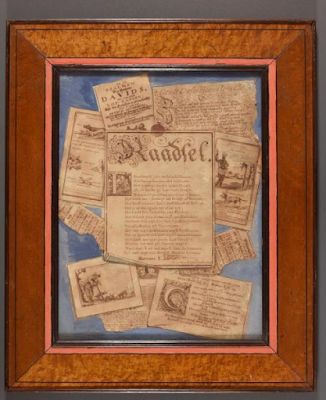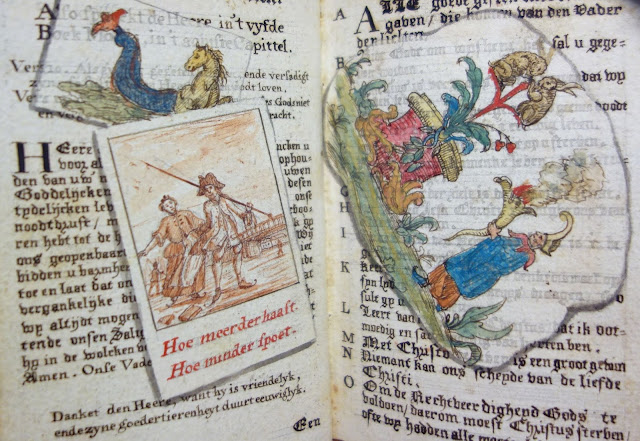Finding the Needle in a Haystack: Research into Trompe L’Oeil in Written Texts (Honours Research part 1 of 3)
Trompe L’Oeil in Books
“handwritten
books that not only offer a meticulous imitation of a printed book (in most
cases a traditional ABC book in black letter serves as a model), but also
pretend to include loose, printed ephemera (images, songs, and texts, mostly in
roman type), paper cuttings, or even a pair of reading glasses”(P.H. Moser).
This is how Trompe L’Oeil books are described by
Nelleke Moser on this website. This definition is helpful to get familiar with in
order to understand the context of the research. But before that, a small
personal introduction is perhaps needed. My name is Alfie Pieterse, I study
Literature & Society at the Vrije Universiteit in Amsterdam, and I am doing
my research project as a part of the Honours Programme under Nelleke Moser’s
supervision. My research goal is to find Trompe L’Oeil books. All of the
currently known books are documented on this website, thanks to Ms. Moser’s
research. They are rather interesting already, but this research will concern
itself with finding additional examples Finding these would help place the
already known works into context, as well as help to answer some rather
interesting questions, like whether all Trompe L’Oeil books are Dutch (since
all known examples are), or why Trompe L’Oeil art is common while Trompe L’Oeil
books are not. Finally, this research was done in two rounds: the first round
consisted of going through university libraries’ databases and coming up with
questions and ways to search, while in the second round the focus lies on contacting
librarians and one expert in the field of publishing, John. A Lane.
Methodology
First
round:
There are multiple ways in which I attempted to
systematically search for more examples of these books. First of all, some
obvious methods include:
1. searching for other works by already known Trompe
L’Oeil authors like Crijn (or Cryn) van Zuyderhoudt;
2. searching for the word ‘trompe l’oeil’ or variations
of it like ‘trompe l’oeil books’, ‘trompe l’oeil literature’, ‘trompe l’oeuil’
(the last one appeared in an English source), and ‘schijnbedrieger’ (from
Nelleke Moser’s article in Jaarboek voor
Nederlandse Boekgeschiedenis);
3. most of these searches were carried out in Dutch,
French and English databases, as well as through Google, but there might be
some other databases that are less likely to yield results, for example, a
Hungarian database like ‘Országos Széchényi Könyvtár’ (The national Széchényi
library), that are still interesting to consider since I can speak Hungarian.
Finally, a last, perhaps less obvious way of doing
research can be:
4. to look up
how the known Trompe L’Oeil books are categorised and to search for those
terms, if there are any. Additionally, a description of these books that is
different from their name can also be thought of and then used to search for
additional examples.
These ways of searching are chosen because of their
systematic approach, but this does not mean that everything that can possibly
be found will also be found because of possible errors in categorising the
books among other things.
Second
round:
The methodology of the second round consisted of contacting
various libraries: the Leiden University Library, the Koninklijke Bibliotheek
in The Hague, Országos Széchényi Könyvtár (the Hungarian national library),
Petőfi Irodalmi Múzeum (A literary museum in Budapest), ELTE Egyetemi Könyvtár
(ELTE university library) and the Pannonhalmi Könyvtár (the library of the
Pannonhalom monastery, which houses a big collection of ancient books).
Additionally, John A. Lane, an American expert in publishing (but with vast
knowledge in everything concerning books) was also contacted. The reason for
contacting these institutions and people, was to gain insight into where I
could find additional examples of Trompe L’Oeil books, and gain insight into
ways in which I could search efficiently.
Results
First
round:
When utilising the first three mentioned ways of doing
research, no previously unknown Trompe L’Oeil books came up. However, there
were some Trompe L’Oeil drawings as can be seen on the following page. These
pages resemble the spirit of the Trompe L’Oeil books in my opinion, but they
are not the same. Databases that were used are: The Leiden University Library, The
Koninklijke Bibliotheek in The Hague, The Zeeuwse Bibliotheek, Allard Pierson,
Early English Books Online (English) and Gallica (French). These are all,
except the last two databases, known sources, and all have at least one known
copy of a Trompe L’Oeil book. The Hungarian databases mentioned before were
also used: the Országos Széchényi Könyvtár (OSZK), the Petőfi Irodalmi Múzeum, ELTE
Egyetemi Könyvtár, and the Pannonhalmi Könyvtár. Terms used were ‘Trompe
L’Oeil’, author’s names like Cryn van Zuyderhoudt, and, since this term does
exist in Hungarian, ‘optikai illúzio könyv’ (optical illusion book). This
yielded no results, unfortunately.
When it comes to my fourth method of doing research, I
ran into a problem: as mentioned in ‘Methodology’, I wanted to see how the
books that are known were categorised, and I came to the conclusion that this
was not helpful for further research. Known works were often categorised as Trompe L’Oeil, and did not contain other
helpful information but the author’s name and the name of the artwork itself. Then
it came to deconstructing the Trompe L’Oeil books into a description and then
use that description (similar to Ms. Moser’s definition in the introduction).
This was used to search for books that would not have the name that one is used
to, but were the same concept nevertheless. Similarly to the Hungarian
databases where I invented a descriptive term to search for these books, this
is what I attempted to do as well.
Second
round:
The second round of research did not result in any
more examples of Trompe L’Oeil books than the first round of research, but
there were other interesting results that I found through this method. Through
Erika Andrási, from the OSZK, I found an engraving from 1716 that depicted
various events of the time in Hungary, which I will mention in detail in my
second blog post. Additionally, John A. Lane mentioned the existence of a book
called Academie de l’Espée, by Gérard
Thibault. A book from around 1628 in which missing pages were replaced by
hand-written pages. This is somewhat similar to Trompe L’Oeil books, but still
different. These were the most interesting findings, but I was also sent other
engravings that were interesting, but not quite what I was looking for.
Finally, something to consider for future research that I learned while talking
to the librarians: the books I was searching for are rare, and in order to look
around in libraries’ rare collections I have to ask permission for looking at
specific books. I did not have any titles to look for, unfortunately, and
searching for Cryn van Zuyderhoudt (the author of some Trompe L’Oeil books) did
not yield results. I could have utilised the librarians’ services more if I
would have had a title to look for, so it would have been helpful if I would
have thought about possible titles in the first round of my research.
Conclusion
It is still difficult to say with certainty if there
are additional examples of these books that exist. It seems to be somewhat of a
Dutch trend. But why would this specifically be Dutch? Were other nations not
interested in Trompe L’Oeil books? Additionally, it seems to only have been
practiced in the 18th century, but Trompe L’Oeil art still exists in
modern times. The more one delves into this topic, the more questions surface. These
aspects make it a niche and mysterious genre, which makes it very interesting
to do research on, but also makes it likely that the research will not yield
the desired results. I did not manage to find additional examples of Trompe
L’Oeil books through the research methodology that was discussed in this post.
I did find other interesting artworks and texts through talking to experts. I
consider these to be positive results of my research, even though I was not
looking for them, I think they still contribute to the Trompe L’Oeil book
discussion. One of these, the engraving that was sent to me by Ms. Andrási,
will be featured in my second blog post. My third and last blog post will
detail what I learned while doing this research.
 |
| Crijn van Zuyderhoudt, "Trompe L'Oeil with Riddle" (Auction.fr) |


Comments
Post a Comment